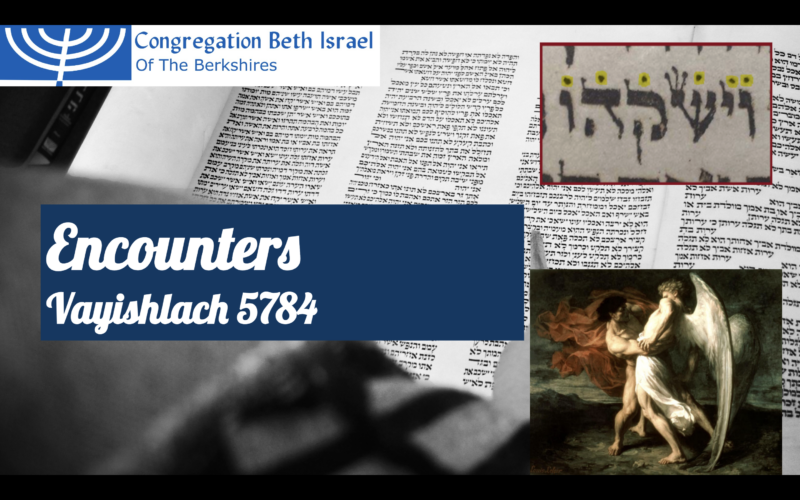There are two big spiritual encounters in this week’s Torah portion, Vayishlach. When the parsha begins Jacob is alone and afraid. He grapples with an angel all night. From that, he gets a new name, Yisrael, one who wrestles with God. (Gen. 32:29) (This is the origin of one of the names our people carries to this day: Yisrael, aka Godwrestlers.) Jacob calls the place where that happened Pni-El, “Face of God,” because of his encounter there with the Holy. (Gen 32:31)
The other encounter is with Jacob’s twin brother Esav, whom he has not seen since they parted on lousy terms many years ago. Remember, Jacob (whose given name can be understood as “the Heel”) tricked their father into giving him the firstborn blessing meant for Esav. Then Jacob fled to escape his furious brother. But now, Esav falls on his neck and kisses him. And Jacob marvels aloud to Esav, “to see your face is like seeing the face of God!” (Gen. 33:10)
I love this. The stranger with whom he wrestled all night is a face of God. And his twin brother whom he had feared to meet again as an enemy… is also a face of God. It seems that Torah this week wants us to be thinking about seeing the face of God. Not only in those whom we instinctively like or trust, but also in those with whom we might grapple or struggle. Even those with whom we might be braced for enmity and violence – they too are faces of the One.
Unfortunately, that’s not usually where our sages take this. Esav gets associated with Rome – and knocking Edom (his descendants) becomes a coded way to bemoan the atrocities of Rome. Or: take that moment when he falls on Jacob’s neck. Our scribal tradition places dots over the word “he kissed him,” which Rashi (d. 1105) reads as a sign of Esav’s ambivalence. Midrash suggests Esav was going to bite him, like a vampire, until Jacob’s neck turned to marble!
The Sforno (d. 1549) wrote, “we live among the descendants of Esau: people who are arrogant, consider themselves invincible.” Medieval rabbis often regarded Christian Europe (where it was not great to be a Jew) as the spiritual descendants of Esav. The political realities of each era got read back into Torah. And the rabbis projected their anxiety about Jewish safety, and the trustworthiness of those whom they saw as fundamentally unlike us, onto Esav.
Our sages lived in times of antisemitism and persecution. They read Torah through what was happening around them. Unfortunately, we also live in a time of rising antisemitism, and it’s easy to retroject today’s news headlines into the Torah. Some connect Edom, Esav’s descendants, with the Palestinians. So does the Jacob-Esav encounter have wisdom for us about current events? It could. But the insight it offers is spiritual, not geopolitical, and it’s about… us.
Torah doesn’t tell us whether Esav genuinely felt love for his brother at their reunion, or whether Esav secretly wanted to bite him in the neck. Torah also doesn’t tell us whether Jacob really saw the face of God in his brother, or whether he was lying through his teeth because that’s what he thought would keep him safe. We get to choose which interpretation we favor. Here’s why I think it’s spiritually valuable to choose to see both brothers positively, especially now.
Genesis is full of brothers fighting. Cain and Abel. Isaac and Ishmael. Jacob and Esav. Joseph and the rest of his brothers. All of those stories are, in a certain way, zero-sum. One brother lives, the other dies. One brother gets lifted up, the other gets kicked out. One brother ges the firstborn blessing, the other gets a curse. One gets a special coat – and then his angry brothers throw him in a pit and sell him into slavery. It’s a whole family tree of favoritism and fighting.
When we choose to see Jacob and Esav’s encounter as genuine, we’re saying: sibling rivalry isn’t the only option. We’re embracing hope for better. We’re affirming that we want to be on a trajectory toward mutual trust, seeing each other generously, creatively visioning a shared future that’s better than our past. We can’t change Torah, but we can change the story of now. Past doesn’t have to be prologue. We can write a different ending.
I read a d’var Torah this week by Rabbi Hannah Jensen called Jacob, Esau, and Jewish-Arab Partnership. She connects how we view Jacob and Esav with an ongoing pattern of “polarization and sides-taking in the name of protecting ourselves and our ‘people.’” I think of my friend and teacher R. Brad Hirschfield’s book You Don’t Have To Be Wrong For Me To Be Right. We don’t have to live in a world of us-vs-them. We can make a different choice.
Letting go of us-vs-them might feel implausible, or unsafe, especially now. I get it. And, today is Shabbes. On this day when we live into the as-if, as-if the work of healing the world were complete, I invite us to broaden our imagination. Imagine a world where it’s not about which group “wins” – but rather a future that’s collaborative and cooperative, where the way to succeed is to lift others up. If we can imagine it, it doesn’t have to be a dream.
Jensen cites Sally Abed, co-founder of Standing Together, saying that the best way for us in America to support the Israeli people is to support the Palestinian people. I think she’s saying: it’s a false binary. One will flourish best when the other flourishes too. This doesn’t have to be motivated by altruism; it’s also enlightened self-interest. Spiritually, it’s good to seek the benefit of all. And practically, extremism loses power when everyone can thrive.
I find hope in organizations like Standing Together and Hand in Hand and Roots who teach coexistence instead of mistrust. I’ve started asking myself: whatever I’m about to do, or say, or argue, will it help people there who are trying to build coexistence? Or is it going to fuel the polarization, the zero-sum sense that only one people can “win”? Jacob and Esav didn’t figure out how to live side by side. But I still have hope that their spiritual descendants can.
This is the d’var Torah that Rabbi Rachel offered at Shabbat services (cross-posted to Velveteen Rabbi.)






